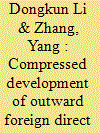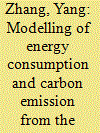| Srl | Item |
| 1 |
ID:
178269


|
|
|
|
|
| Summary/Abstract |
Unlike the conventional understanding of China’s outward foreign direct investment, we found that the pattern of compressed development better reflects China’s outward foreign direct investment in the 21st century. The compressed development of Chinese outward foreign direct investment is characterized by a much higher growth rate than that of earlier industrializers and greater structural changes in types of investment, investors and destination countries. These changes result in new challenges to the Chinese government in dealing with domestic and foreign actors. Nevertheless, these challenges also create incentives for the Chinese government to improve how it interacts with Chinese investors and regulates their investment behavior.
|
|
|
|
|
|
|
|
|
|
|
|
|
|
|
|
| 2 |
ID:
073457


|
|
|
| 3 |
ID:
169714


|
|
|
|
|
| Summary/Abstract |
A rapid rise in China's construction scale due to urbanization has resulted in a large amount of energy consumption and carbon emission. In order to achieve carbon emission reduction and energy security, it is important to assess the energy use of and emissions from the building construction sector. This paper presents a China Building Construction Model (CBCM) based on a process-based life cycle assessment (LCA) approach and discusses the trends in energy consumption of and carbon emission regarding China's building construction sector from 2000 to 2016. In 2016, the total energy consumption of the building construction sector was 411 million tce, accounting for approximately 9% of the country's total energy consumption. The construction activities of urban residential, public, and commercial buildings have replaced rural residential buildings as the main source of energy consumption and emission. Construction scale, building structure type, and material production efficiency are the three important driving factors. A decline in China's building construction scale, promotion of new low carbon building structures, and improvement in production efficiency may reduce future energy use and carbon emissions related to the building construction sector.
|
|
|
|
|
|
|
|
|
|
|
|
|
|
|
|